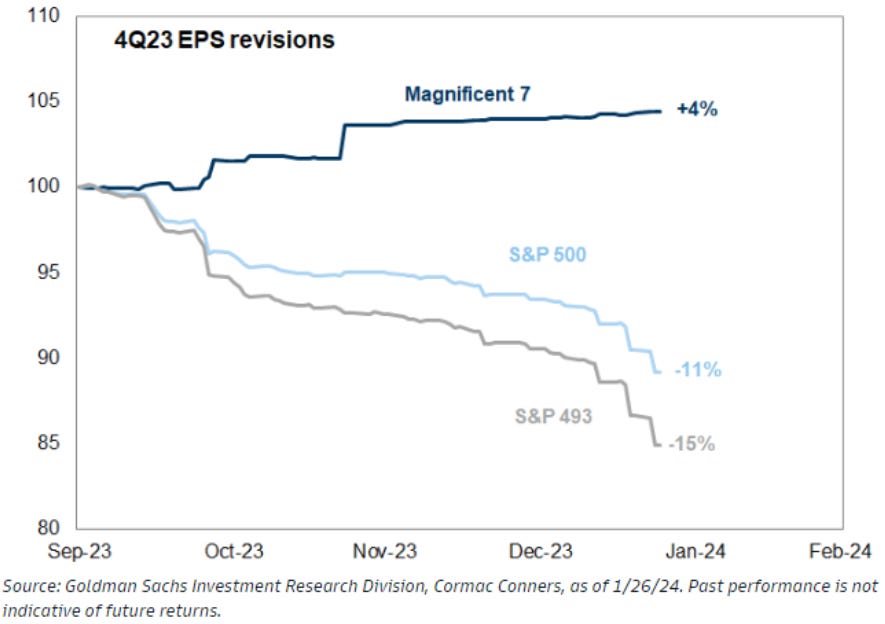Charts of the Week
If you are wondering why the stock market keeps going up — at least, the former Magnificent Seven which is now down to five, with Apple struggling and Tesla swooning — this image from Charles Schwab’s Liz Ann Sonders is explanatory. As you can see, financial conditions are now the easiest in almost two years. This was prior to the worst of 2022’s brutal bear market in both stocks and bonds. Considering how much tightening the Fed has done since then, this is a remarkable development. It speaks to how much financial markets have eased by reducing interest rates and narrowing credit spreads. (The latter involve the yield gap between government and corporate debt; when that narrows, as it has dramatically since the summer of 2022, stocks and bonds typically rally hard which has indeed occurred.)
Related to the continuing outperformance of the Magnificent Seven (Five?) is the far better earnings performance they have been delivering and/or are expected to deliver. The fact that fourth quarter profits estimates have been slashed as much as they have for the S&P 493 is surprising. This is because an earnings recession already played out last year, though a mild one. But even more perplexing is that the federal government deficit doubled in fiscal year 2023 (ended September 30th ). Moreover, federal red ink is hemorrhaging even more profusely in the first quarter of fiscal 2024. High levels of deficit spending nearly always correspond with soaring corporate profits. This is a reality stock market bulls are currently overlooking.
“Demand for raw materials is at record levels, inventories are low, and spare production capacity is largely exhausted. This is just classic ‘own commodities.’” -Jeff Curie, former head of commodities research at Goldman Sachs.
Muirly a Coincidence…
If adversity makes you stronger, assuming it doesn’t kill you, it’s reasonable to conclude that it was a positive and resilience-building experience. That sounds so comforting. However, as someone who is one of the few oil-and-gas bulls left on the planet, I will admit that rigor mortis may set in for me at any moment.
The one thing staving off the grim reaper might be my willingness to take advantage of “dead-cat bounces”. Those are the feeble rallies that typically accompany asset classes that have been on the receiving end of a constant flagellation that could make the Marquis de Sade wince. For almost two years now, the rebound off of terra firma by feline cadavers has been pretty much as good as it gets in the desolate world of energy investing. (Fossil-fuel investors, take heart — it could have been worse; you could have been holding that ripping bag known as alternative energy securities, which have been anything but secure.)
The most recent case in point was the sneaky rally that oil performed since early December. Last week, that amounted to a 12% pop from trough to peak — not bad for less than a month. This was enough of a reversal to cause me to downgrade crude to a hold a week ago. Said rating reduction was despite an untimely 2% swoon on the same day that Making Hay Monday (MHM) went out the digital door. In that edition of MHM, I stated my intent to run in today’s Haymaker one of the rarest of all research notes: an actual bullish piece on oil. Further, I explained it was from Kevin Muir who has given me permission to rebroadcast his first-rate work whenever I am so inclined. Today, with oil getting slammed for the third day in a row, I am very much inclined to showcase any credible analysis that offers hope to the shrinking herd of wounded energy bulls.
Before getting to Kevin’s latest persuasive musings, I will elucidate that, as most Haymaker readers are aware (I hope), I have used the occasional fleeting rallies oil has seen since the hockey-stick move caused by the war in Ukraine to cash in some gains. This was, of course, after buying into at least two of the plunges seen since then. (The rebound coming out of last June was particularly rewarding.)
One of the techniques I’ve used to get a sense of when the worst of oil’s bungee jumps might have been over is when sentiment has become exceedingly bearish. This can be measured in several ways, as Kevin describes near the end of this note. As my team and I at Evergreen also do, he uses positioning in the futures market as a critical input. Per numerous previous comments I’ve made on the participants behind these readings, their hyperactive nature makes them excellent contrary indicators. In other words, when they are all-in with bearish bets you usually want to be adding exposure and vice versa. (It’s been a lot more versa than vice since the spring of 2022.)
As you will read, Kevin has also been waiting for a sign that the most recent downtrend, which started in late September, has been broken. The aforementioned rally gave him just such a signal. Alas, as has been the pattern for these last nearly two years, its life cycle was about as long as a tsetse fly. After the drubbing since Tuesday, oil is now down 8% from last Friday’s close — i.e., really bad in just a week. To put this in perspective, that would be like the Dow shedding 3000 points. A stock market decline of that magnitude would, of course, be front-page news. For the oil market, it’s simply another week at the office. Yet, despite this latest setback, I think Kevin’s reasoning is sound and his timing is, as our title indicates, unusually coincidental. His point about the exceptionally low levels of oil inventories is spot-on, in my view. In fact, I think it’s utterly brilliant since it’s one I’ve made repeatedly over the last year or so. As you will see, his last visual in that regard would seem to be consistent with oil prices and sentiment at lofty levels instead of in the dumpster, as they are presently.
He’s also right that the futures market is currently in backwardation (spot prices higher than future prices as opposed to the far more normal opposite condition). This is another indication of an undersupplied condition. Why the sellers come out of the woodwork at the slightest whiff of bad news given this backdrop is a mystery. However, it’s merely stating the obvious that many in positions of power prefer to see prices depressed. Of course, consumers do, too.
The problem is, as the old saying goes, the cure for low prices, is low prices. If they are being artificially driven down, this may ultimately lead to serious shortages and a future cost of crude well into triple-digits. The fact that the drilling rig count is down sharply and is continuing to fall is one example of the law of unintended consequences.





